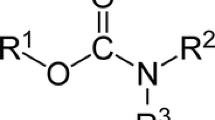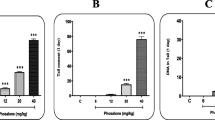Abstract
Some of organophosphate pesticides which are the most heavily used in Korea, were examined for their effects on the murine immune system.
Immunotoxicological assay parameters adopted in this study were Arthus reaction for humoral immunity, delayed type hypersensitivity reaction for cell mediated immunity, carbon clearance for macrophage function and susceptibility to tumor challenge.
Subchronic exposure of rodents to the pesticides resulted in the marked suppression of immune functions and enhancement of susceptibility to tumor challenge.
Among the pesticides tested (fenitrothion, fenthion, diazinon and EPN), fenitrothion was the most suppressive in Arthus and delayed type hypersensitivity reaction.
Similar content being viewed by others
Literature Cited
Dean, J.H., Luster, M.I., Boorman, G.A. and Lauer, L.D.: Procedures available to examine the immunotoxicity of chemicals and drugs.Pharmacol. Reviews,34(1), 137 (1982).
Ercegovich, C.D.: Relationship of pesticides to the immune response.Fed. Proc.,32, 210 (1973).
Koller, L.D.: Effects of environmental contaminants on the immune system.Advan. Vet. Sci. Comp. Med.,23, 267 (1979).
Koller, L.D.: Immunotoxicology of heavy metals.Int. J. Immunopharmacol.,2, 269 (1980).
Koller, L.D.: Immunologic effects of cadmium. “cadmium in the environment”, part 2, New York, John Willey and Sons Inc. pp 719, 1981.
Vos, J.G., Immune suppression as related to toxicology.CRC Crit. Rev. Toxicol.,5, 67 (1977).
Balkhovityanova, V.M.,et al.: Effect of Sevin, a pesticide, on the formation of antitoxic immunity in experimental animals.Vrachevnoe. Delo.,8, 116 (1968).
Vos, J.G. and Krajnc, E.I.: Immunotoxicity of pesticides. In “Developments in Science and Practice of Toxicology”. 229, 1983.
Street, J.C.: Pesticides and the immune system in rat.Ann. N.Y. Acad. Sci.,45 1, (1981).
Moon, C.K., Immunotoxicological aspects of pesticides,Symposium, Korean Society of Food Hygiene, 1986.
Agricultural Chemicals Industrial Association, Seoul, Korea., “Agrochemical Year Book.,” 1984.
Luster, M.I., Dean, J.H. and Moore, J.A.: Evaluation of immune functions in toxicology. In “Principles and Methods of Toxicology”, Raven Press, New York, pp561, 1982.
Moon, C.K.,et. al.,: Effects of some organophosphate pesticides on the murine immune system following subchronic exposure (I), submitted.
Henningsen, G.M., Koller, L.D., Exon, J.H., Talcott, P.A. and Osbone, C.A.: A sensitive delayed type hypersensitivity model in the rat for assessing in vivo cell mediated immunity.J. Immunol. Methods,70, 153 (1984).
Stuart, A.E., Habeshaw, J.A. and Davidson, A.E.: The carbon clearance test forin vivo phagocytosis. In “Handbook of Experimental Immunology”, vol. 2, 3rd ed, Blackwell, Oxford, 1979.
Dimov, I.,et al.: Effects of fenitrothion and phosalon on the immunologic reactivity of sheep.,Vet-Med.,22, 38 (1985).
Musson, R.A. and Becker, E.L., The role of an activable esterase in immune dependent phagocytosis by human neutrophils.J. Immunol.,118, 1354 (1977).
Taurog, J.D., Fewtrelle, C. and Becker, E.L., IgE mediated triggering of rat basophil leukemia cells: lack of evidence for serine esterase activation.J. Immunol.,122, 2150 (1979).
Casale, G.P., Cohen, S.D. and Dicapua, R.A., The effects of organophosphate induced cholinergic stimulation on the antibody response to SRC in inbred mice.Toxicol. Appl. Pharmacol.,68, 198 (1983).
Whaley, K., Lappin, D. and Barkas, J., C2 synthesis by human monocytes is modulated by a nicotinic cholinergic receptor.Nature (London),293, 580 (1981).
Szot, R.J. and Murphy, S.D.: Phenobarbital and dexamethasone inhibition of the adrenocortical response of rats to toxic chemicals and other stresses.Toxicol. Appl. Pharmacol.,17, 761 (1970).
Riley, V.: Psychoneuroendocrine influences on immunocompetence and neoplasia.Science, 212, 1100 (1981).
Gillis, S., Crabtree, G.R. and Smith, K.A.: Glucocorticoid-induced inhibition of T-cell growth production.J. Immunol.,123 (4), 1624 (1979).
Author information
Authors and Affiliations
Rights and permissions
About this article
Cite this article
Moon, C.K., Yun, Y.P. & Lee, S.H. Effects of some organophosphate pesticides on the murine immune system following subchronic exposure (II). Arch. Pharm. Res. 9, 183–187 (1986). https://doi.org/10.1007/BF02900004
Received:
Issue Date:
DOI: https://doi.org/10.1007/BF02900004




